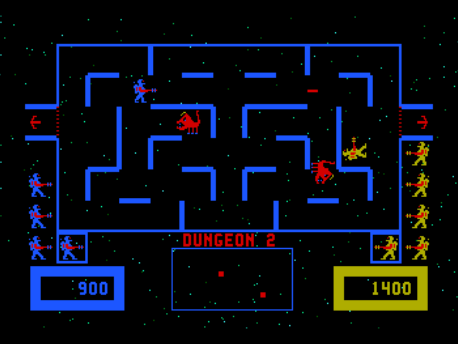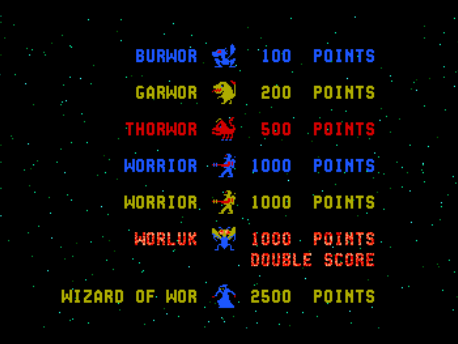

I've always been fascinated by the history of video games. Being born in the mid 70s, I quite literally grew up with the hobby, and have many memories of playing games at many different times in my life. For Co-Op Classics today, we'll take a look at what most video game historians consider a minor title: Wizard of Wor. Since it was released along with mega-classics like Pac-Man, Defender, and Centipede, and other hits from the extremely crowded arcade field in 1980, I have no clear memory of playing it. But Wizard of Wor stands out from the rest as a very early example of cooperative gameplay.
If you just look at screenshots, Wizard of Wor looks like a Pac-Man ripoff. The playing field is a maze, filled with monsters out to get you. The protagonist is even yellow, for crying out loud! But upon deeper inspection, the similarities to Pac-Man end. The hero in Wizard of Wor, known as a Worrior, wearing what looks like a spacesuit an armed with a laser rifle, has entered the labyrinthine dungeon of the mad Wizard. Only by killing the Wizard's monstrous creations can the Worrior advance deeper into the dungeon, hoping to hunt down the Wizard himself. As the Worrior fights his way through more and more difficult levels, the Wizard taunts him relentlessly.

There's a real sense of menace and urgency as you play Wizard of Wor. The music, a synthesized bass rendition of the famous "Dragnet" theme, is quite eerie, compared to the whimsical beeps and boops of other games from the period. The Wizard of Wor himself actually speaks during the game, commenting on your play and laughing at you from time to time. The laughter sounds more like "ka ka ka ka" than "ha ha ha ha", but any speech at all was a real novelty in 1980. The music, sounds, and especialy speech in Wizard of Wor added greatly to the overall tension of the experience.
This tension was also enhanced by the behavior of the enemies themselves. To begin, each level contained relatively slow moving, wolfish creatures called Burwors. Once defeated, the Burwors spawned yellow reptilian Garwors, who were in turn replaced by Thorwors, quick red scorpions. These latter two monsters were able to actually turn invisible when they weren't in the same corridor as a Worrior. Luckily, a radar screen at the bottom of the display showed you were they were even when they were invisible. Even so, it was still very difficult to track them, especially since the mazes themselves changed with each new level, and you couldn't really get too familiar with your surroundings.

Once the last Thorwor fell to a blast of laser fire, the Worluk appeared. A fast moving, insectoid beast, the Worluk dashed quickly for one of the exits. If a Worrior had quick enough reflexes to slay the Worluk, the next level would be a double point dungeon. After the third dungeon, the Wizard himself appears after the Worluk, teleporting all over the maze and shooting lightning bolts. This progression routine for monster spawns made the game that much more intense and intimidating, especially when enemies developed the talent to shoot back at you!
But the best innovation in Wizard of Wor was two-player simultaneous gameplay. Even when one person was playing, the computer would play along as the second player. For some bizarre reason, this second Worrior was clad in blue, often blending in with the walls and even some of the monsters. Two player simultaneous play, in and of itself, was very, very unusual this early in the arcade era, so its unsurprising that the co-op wasn't exactly as we define it. Similar to the later game Joust, players could choose to work together, or even against one another. In fact, one could even argue that Wizard of Wor encouraged players to fight, since points were awarded for killing the other player! Honestly, though, the game itself was difficult enough without having to dodge another player. Since the end goal was to maximize the time spent playing per quarter, working together as a team was the best way to do just that.
Wizard of Wor is one of the earliest games in the Co-Optimus database. Only Fire Truck was earlier, while Space Invaders II came out the same year. It's fascinating to see how cooperation was implemented into these early Golden Age arcade titles. Wizard of Wor's take on teamwork is not quite as robust as we'd like, perhaps, but it was certainly a step in the right direction. The concept of teaming up with a friend, back to back, covering for each other, as wave after wave of enemies approach is certainly one that has held up through the decades. And in 1980, the co-op was more than enough to make you "Come back for more... with the Wizard of Wor!"